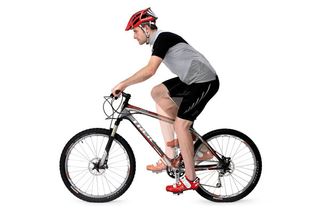Bike set-up tips
Small adjustments to your bike's components can lead to big improvements

Frame size
Buying the right-sized frame is thefirst step to a great bike fit. The three measurements to take are yourinside leg, your inside leg plus torso up to the base of your neck andyour arm length from wrist to shoulder. Subtract 34cm-42cm from yourinside leg to find your frame size. For an even more accuratemeasurement, subtract your inside leg from your inside leg plus torso,then add this number to your arm length. Multiply this by between 0.47and 0.5 (0.5 being an aggressive racing position).
Handlebar reach
You should be able to ride with relaxed arms and hands. If you get tension in your neck and traps when riding or you have to lock your arms to reach the bars, you may be overreaching. Reach is affected by both height of the handlebars and the length of the stem. See how your weight splits between saddle and bars - a load on your hands greater than 40 per cent can lead to numbness and pain. Try cycling with the handlebars at different heights to find the correct reach.
Handlebar width
The width of your bars should match the width of your shoulders, with your hands and shoulders directly aligned. You can cut bars down to achieve this. Adjust your brake levers and gear shifters so that your hands stay aligned with your forearms as you pull on the brake levers.
Saddle position
The Knee Over Pedal (KOP) check should be done by clipping into your pedals and placing the crank at nine o'clock (horizontal). For optimal power adjust your saddle's position forward or backward so that the bony lump below your kneecap is directly over the pedal axle.
Saddle width
The back of your saddle should be wide enough to support both bones that lie underneath your glutes. This avoids discomfort in the soft tissue of your undercarriage. Set your saddle so it's level or you'll slip forwards or backwards as you ride.
Saddle height
Set the saddle so your leg is bent 30˚ when your pedal is at the bottom of the stroke. An angle greater than 35˚ can stress your knees, while less than 25˚ reduces power and can overstretch your legs. Hang a plumb line from your knee and use a protractor to measure this.
Pedals
All of the locomotive force generated on a bike goes through the interface between foot, cleat and pedal. Clipless pedals are the most efficient way to use this power but you need to get the position right. The ball of your foot should be directly over the pedal axle and middle of the cleat. If your foot is outside your knee and hip as you pedal, move the cleat closer to the crank, and vice versa.
Sign up for the Men's Fitness Rough Track Triathlon here.
Get the Coach Newsletter
Sign up for workout ideas, training advice, reviews of the latest gear and more.
Check out these tips from a past Rough Track champion.
Want more expert triathlon advice? Then subscribe to Men's Fitness magazine, we'll give you three issues for £1!
Coach is a health and fitness title. This byline is used for posting sponsored content, book extracts and the like. It is also used as a placeholder for articles published a long time ago when the original author is unclear. You can find out more about this publication and find the contact details of the editorial team on the About Us page.

